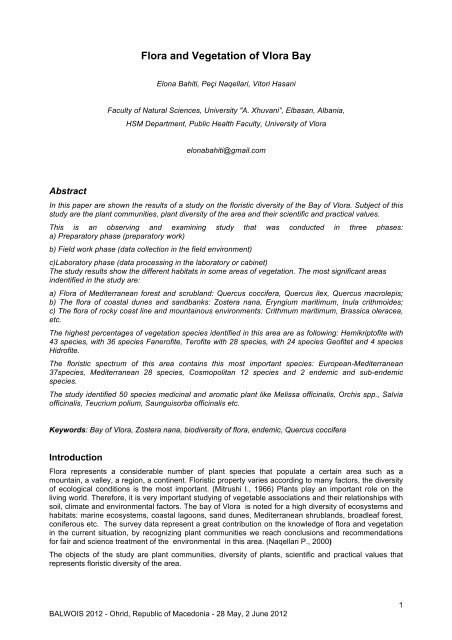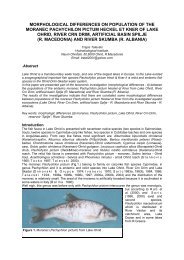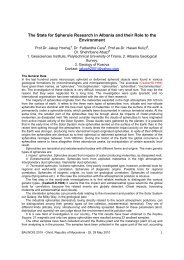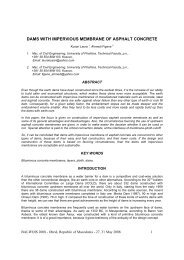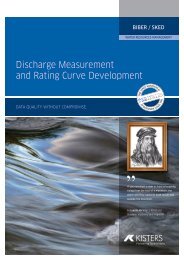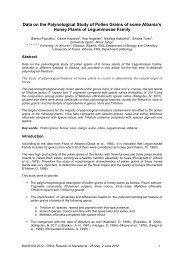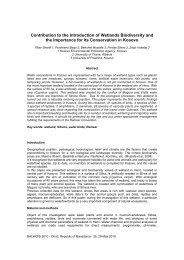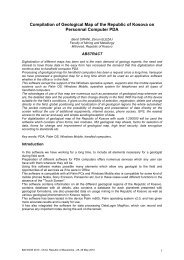Flora and Vegetation of Vlora Bay
Flora and Vegetation of Vlora Bay
Flora and Vegetation of Vlora Bay
Create successful ePaper yourself
Turn your PDF publications into a flip-book with our unique Google optimized e-Paper software.
Abstract<br />
<strong>Flora</strong> <strong>and</strong> <strong>Vegetation</strong> <strong>of</strong> <strong>Vlora</strong> <strong>Bay</strong><br />
Elona Bahiti, Peçi Naqellari, Vitori Hasani<br />
Faculty <strong>of</strong> Natural Sciences, University "A. Xhuvani”, Elbasan, Albania,<br />
HSM Department, Public Health Faculty, University <strong>of</strong> <strong>Vlora</strong><br />
elonabahiti@gmail.com<br />
In this paper are shown the results <strong>of</strong> a study on the floristic diversity <strong>of</strong> the <strong>Bay</strong> <strong>of</strong> <strong>Vlora</strong>. Subject <strong>of</strong> this<br />
study are the plant communities, plant diversity <strong>of</strong> the area <strong>and</strong> their scientific <strong>and</strong> practical values.<br />
This is an observing <strong>and</strong> examining study that was conducted in three phases:<br />
a) Preparatory phase (preparatory work)<br />
b) Field work phase (data collection in the field environment)<br />
c)Laboratory phase (data processing in the laboratory or cabinet)<br />
The study results show the different habitats in some areas <strong>of</strong> vegetation. The most significant areas<br />
indentified in the study are:<br />
a) <strong>Flora</strong> <strong>of</strong> Mediterranean forest <strong>and</strong> scrubl<strong>and</strong>: Quercus coccifera, Quercus ilex, Quercus macrolepis;<br />
b) The flora <strong>of</strong> coastal dunes <strong>and</strong> s<strong>and</strong>banks: Zostera nana, Eryngium maritimum, Inula crithmoides;<br />
c) The flora <strong>of</strong> rocky coast line <strong>and</strong> mountainous environments: Crithmum maritimum, Brassica oleracea,<br />
etc.<br />
The highest percentages <strong>of</strong> vegetation species identified in this area are as following: Hemikript<strong>of</strong>ite with<br />
43 species, with 36 species Faner<strong>of</strong>ite, Ter<strong>of</strong>ite with 28 species, with 24 species Ge<strong>of</strong>itet <strong>and</strong> 4 species<br />
Hidr<strong>of</strong>ite.<br />
The floristic spectrum <strong>of</strong> this area contains this most important species: European-Mediterranean<br />
37species, Mediterranean 28 species, Cosmopolitan 12 species <strong>and</strong> 2 endemic <strong>and</strong> sub-endemic<br />
species.<br />
The study identified 50 species medicinal <strong>and</strong> aromatic plant like Melissa <strong>of</strong>ficinalis, Orchis spp., Salvia<br />
<strong>of</strong>ficinalis, Teucrium polium, Saunguisorba <strong>of</strong>ficinalis etc.<br />
Keywords: <strong>Bay</strong> <strong>of</strong> <strong>Vlora</strong>, Zostera nana, biodiversity <strong>of</strong> flora, endemic, Quercus coccifera<br />
Introduction<br />
<strong>Flora</strong> represents a considerable number <strong>of</strong> plant species that populate a certain area such as a<br />
mountain, a valley, a region, a continent. Floristic property varies according to many factors, the diversity<br />
<strong>of</strong> ecological conditions is the most important. (Mitrushi I., 1966) Plants play an important role on the<br />
living world. Therefore, it is very important studying <strong>of</strong> vegetable associations <strong>and</strong> their relationships with<br />
soil, climate <strong>and</strong> environmental factors. The bay <strong>of</strong> <strong>Vlora</strong> is noted for a high diversity <strong>of</strong> ecosystems <strong>and</strong><br />
habitats: marine ecosystems, coastal lagoons, s<strong>and</strong> dunes, Mediterranean shrubl<strong>and</strong>s, broadleaf forest,<br />
coniferous etc. The survey data represent a great contribution on the knowledge <strong>of</strong> flora <strong>and</strong> vegetation<br />
in the current situation, by recognizing plant communities we reach conclusions <strong>and</strong> recommendations<br />
for fair <strong>and</strong> science treatment <strong>of</strong> the environmental in this area. (Naqellari P., 2000)<br />
The objects <strong>of</strong> the study are plant communities, diversity <strong>of</strong> plants, scientific <strong>and</strong> practical values that<br />
represents floristic diversity <strong>of</strong> the area.<br />
BALWOIS 2012 - Ohrid, Republic <strong>of</strong> Macedonia - 28 May, 2 June 2012<br />
1
The main issues <strong>of</strong> the study are:<br />
- Distinguishing flora <strong>and</strong> different spectrum <strong>of</strong> the area.<br />
- The determination <strong>of</strong> the main plants associations<br />
- Determination <strong>of</strong> the main structure <strong>of</strong> each association found with its data.<br />
- The environmental assessment <strong>and</strong> its impact on natural situation, highlighting the rare plants,<br />
with scientific <strong>and</strong> practical value.<br />
<strong>Flora</strong> <strong>and</strong> vegetation <strong>of</strong> an area are a great resource for national economic <strong>and</strong> scientific value.<br />
Therefore we try to find a definition on plants that are grown in our environment, in our case we have<br />
analyzed some <strong>of</strong> them in this study.<br />
Material <strong>and</strong> Methods<br />
<strong>Vlora</strong> is situated in a subtropical area with Mediterranean climate. This climate combines warm<br />
seawaters <strong>and</strong> fresh mountain air. Its mild climate, which gets even milder due to the special locations <strong>of</strong><br />
<strong>Vlora</strong> among high mountains next to the sea. <strong>Vlora</strong> <strong>Bay</strong> is located in eastern coast <strong>of</strong> the southeastern<br />
Adriatic Sea.<br />
Major roles in the floristic diversity <strong>of</strong> this area have Geomorphologic, climatic <strong>and</strong> environmental factors.<br />
This area has a high diversity <strong>of</strong> habitats. Mediterranean forests <strong>and</strong> shrubl<strong>and</strong>s represent a variety <strong>of</strong><br />
types, where are mentioned Pinus pinea, Erica arborea, etc. In shrubs are raised Quercus coccifera.<br />
S<strong>and</strong>banks area <strong>and</strong> coastal dunes consists <strong>of</strong> species such as, Eryngium maritimum <strong>and</strong> Inula<br />
crithmoides while rocky coastal areas consist <strong>of</strong> Sedum album, Ceterach <strong>of</strong>ficinarum, etc.<br />
As plants have an important role on living world, in this case study <strong>of</strong> plant associations <strong>and</strong> their relation<br />
with l<strong>and</strong>,climate, <strong>and</strong> enviromental factors have a great impact. Nowadays floristic studies have<br />
received several dimensions <strong>and</strong> deepening.What puts flora in danger in regional <strong>and</strong> world level is the<br />
reduction <strong>of</strong> plant, this dangerous phenomena reduce genetik fond <strong>of</strong> plants.( Ruci B., 1983)<br />
There are used two well-known methods to conduct this study: Physiognomic method <strong>and</strong> floristic<br />
method. (Xhulaj M., 2005: Buzo K., 2000)<br />
Physiognomic method is based on the outer morphological construction <strong>of</strong> plants cover <strong>and</strong> in the vital<br />
forms. According to this method, the plants are grouped in some forms, which are based on the height <strong>of</strong><br />
the vegetative buds from the earth surface.<br />
Floristic method based on the identification <strong>of</strong> plant species, which are present in their habitats. The<br />
process is divided in three phases: completing the surveys; evaluating <strong>of</strong> the plant species abundance –<br />
dominance; the determination <strong>of</strong> the species that were in the analyzed place. The determination is<br />
realized by identifying <strong>and</strong> nominating them using the appropriate literature. (Demiri M., 1983: Group <strong>of</strong><br />
Authors, 1988, 1992, 1996, 2000; Tutin T. G. etj., 1964-1980: Ruci B., 2000; Xhulaj M., Kashta L., 2003.)<br />
This study is conducted according to a methodology divided in three phases:<br />
a) Preparatory phase during this phase, there are gathered general data on the area as: physicalgeographical<br />
conditions, terrestrial <strong>and</strong> climatic conditions, <strong>and</strong> data on previous studies on this field. It is<br />
gathered all necessary materials <strong>and</strong> there are organized expeditions in the area.<br />
b) Field work phase (data collection in the field environment)<br />
This survey was carried in different seasons in the area. This was realized in order to obtain many<br />
fen<strong>of</strong>aze <strong>and</strong> different types <strong>of</strong> plants. We have made a complete description <strong>of</strong> the environment for each<br />
surveying parcels, <strong>and</strong> gathered other data such as scientific name <strong>of</strong> plant, geographic location <strong>and</strong> vital<br />
form for each type, etc., according to the respective methodologies.<br />
c) Laboratory phase (data processing in the laboratory or cabinet)<br />
In this phase, there are named the collected plants <strong>and</strong> their communities; realizing floristic <strong>and</strong> biological<br />
spectra.<br />
The study is illustrated with graphics, tables <strong>and</strong> photos.(Figure 9 – 33)<br />
BALWOIS 2012 - Ohrid, Republic <strong>of</strong> Macedonia - 28 May, 2 June 2012<br />
2
Results <strong>and</strong> discussion<br />
This study is based on the separation <strong>of</strong> habitat in three areas <strong>of</strong> study:<br />
1. <strong>Flora</strong> <strong>of</strong> Mediterranean forest <strong>and</strong> scrubl<strong>and</strong>:<br />
Mediterranean forest represents a diversity <strong>of</strong> species on floristic composition.<br />
There are some locations dominated by Pinus pinea, accompanied by Myrtus communis, Carpinus<br />
orientalis, Erica arborea, Pinus halepensis. This area is known for oaks vegetations, which belongs to<br />
Oleo-Ceratonion <strong>and</strong> Quercion ilicis alliances. Plant communities <strong>of</strong> the alliance Oleo-Ceratonion grow<br />
up in dry rocky areas <strong>and</strong> near the seacoast. Typical species are: Ceratonia siliqua, Juniperus<br />
oxycedrus, Thymus capitatus etj.<br />
Vegetable associations <strong>of</strong> the alliance Quercion ilicis are exp<strong>and</strong>ed in locations with limestone cliffs <strong>and</strong><br />
flysch or close to coast protected by wind (Sazan)<br />
This alliance included groups with Quercus coccifera, located in rocky areas. Typical species are :<br />
Smilax aspera, Pistacia lentiscus etj. Associations with Quercus ilex are located in Sazan, Karaburun <strong>and</strong><br />
Llogara. Associations with Quercus macrolepis, are located in Karaburun, which constitutes the northern<br />
limit <strong>of</strong> its exp<strong>and</strong>.<br />
Most common species in this area are: Phlomis fruticosa, Thymus capitatus, Origanum vulgare, Salvia<br />
<strong>of</strong>ficinalis, etc (Figure 1-4)<br />
Fig. 1 Quercus coccifera<br />
Fig. 3 Quercus coccifera<br />
2. <strong>Flora</strong> <strong>of</strong> coastal dunes <strong>and</strong> s<strong>and</strong>banks<br />
BALWOIS 2012 - Ohrid, Republic <strong>of</strong> Macedonia - 28 May, 2 June 2012<br />
Fig. 2 Pinus nigra<br />
Fig. 4 Smilax aspera<br />
The bay <strong>of</strong> <strong>Vlora</strong> distinguishes by a variety <strong>of</strong> marine habitats: s<strong>and</strong>y substrates, rocky areas battered by<br />
waves, microenvironments affected by fresh waters, etc. This area has the kseromorfe structure. On the<br />
<strong>Bay</strong> <strong>of</strong> <strong>Vlora</strong> are found 4 marine phanerogams: Zostera nana, Posidonia oceanica, Cymodocea nodosa<br />
<strong>and</strong> Halophila stipulacea. Associated species <strong>of</strong> laguna are represented by halophilic species such as<br />
3
Inula crithmoides, Juncus maritimus, Limonium vulgare, Atriplex hastata etc. While the vegetation <strong>of</strong><br />
s<strong>and</strong> dunes is represented by: Cakile Maritima, Salsola horse, Cyperus capitatus, Echinophora spinosa,<br />
Eryngium maritimum etc.(Figure 5-6)<br />
Fig. 5 Juncus maritimus<br />
Fig. 6 Eryngium maritimum<br />
3. <strong>Flora</strong> <strong>of</strong> rocky coast line <strong>and</strong> mountainous environments<br />
This area includes plant species that live in the clefts <strong>of</strong> rocks <strong>and</strong> dust. These species have a high<br />
resistance on humidity <strong>and</strong> changes <strong>of</strong> temperatures. This area has the kseromorfe structure. Extends in<br />
the form <strong>of</strong> a narrow b<strong>and</strong> <strong>of</strong> 2-3 m above sea level, across the rocky coast <strong>of</strong> <strong>Vlora</strong> bay (Uji i Ftohte,<br />
Jonufër etc.) . Typical species are: Crithmum maritimum, Limonium anfractus, Brassica oleracea, etc.<br />
Suculente species are : genders <strong>of</strong> Sedum, Sempervivum, etc. (Figure 7-8)<br />
Fig. 7 Brassica oleracea<br />
BALWOIS 2012 - Ohrid, Republic <strong>of</strong> Macedonia - 28 May, 2 June 2012<br />
Fig. 8 Sedum album<br />
For each area are shown systematic, biological <strong>and</strong> florystic spectrum. Based on data for the study<br />
areas we conclude that: The highest percentages <strong>of</strong> vegetation species identified in this area are as<br />
following: Hemikript<strong>of</strong>ite with 43 species, with 36 species Faner<strong>of</strong>ite, Ter<strong>of</strong>ite with 28 species, with 24<br />
species Ge<strong>of</strong>itet <strong>and</strong> 4 species Hidr<strong>of</strong>ite. The floristic spectrum <strong>of</strong> this area contains this most important<br />
species: European-Mediterranean 37species, Mediterranean 28 species, Cosmopolitan 12 species <strong>and</strong> 2<br />
Endemic <strong>and</strong> Sub-endemic species. (Figure1; Figure 2)<br />
During expeditions we identified 187 plants.A part <strong>of</strong> them are shown in Table 1. This area is well known<br />
for medicinal <strong>and</strong> aromatic plants, which have wide use ranging from popular to pharmaceuticals. Their<br />
popular use is very helpful for our health without side effects. List <strong>of</strong> medicinal <strong>and</strong> aromatic plants are<br />
given in Table 2.<br />
Two endemic types are:<br />
1). Valentinum subsp. vlorense – Bilbylbardha e Vlorës<br />
Located in coastal rocks in Jonufer <strong>and</strong> near Orikum. With a height <strong>of</strong> 10-15 m above the sea level.<br />
2). Hypericum haplophylloides – Lulebasani në trajtë hapl<strong>of</strong>ille.<br />
Located in Llogara, up to 750 m above the sea level.<br />
4
2<br />
6<br />
3<br />
4<br />
6<br />
Figure 1: Spectrum <strong>of</strong> vital forms Figure 2: Floristic spectrum<br />
2%<br />
8%<br />
8<br />
0%<br />
Conclusions<br />
2%<br />
31<br />
44%<br />
36<br />
% 3% 3% 3%<br />
%<br />
2%<br />
Figure 3: Family richness<br />
The vegetation area from the description shows that it is well known for a variety <strong>of</strong> habitats, associations<br />
<strong>and</strong> plant species. Here are distinguished varieties <strong>of</strong> habitats such as lagoon, marine, coastal rocks, oak<br />
spaces, shrub l<strong>and</strong>s, s<strong>and</strong> dunes, etc. In this area are gathered special taxon as endemic (2 types), sub<br />
endemic (3 types), <strong>and</strong> 50 types <strong>of</strong> medical <strong>and</strong> aromatic plants.<br />
During this study, we have described three areas: a) <strong>Flora</strong> <strong>of</strong> Mediterranean forest <strong>and</strong> scrubl<strong>and</strong>s, b)<br />
the flora <strong>of</strong> coastal dunes <strong>and</strong> s<strong>and</strong>banks c) the flora <strong>of</strong> rocky coastline <strong>and</strong> mountainous environments.<br />
For each zone are presented systematic, biological <strong>and</strong> florisistic spectrum that show how plant species<br />
adapted the environmental conditions in the study area. During expeditions in the field were evidenced<br />
approximately 187 plant species, grouped in 79 families. In which families with a high percentage <strong>of</strong><br />
species are: Labiatae,(%) Leguminosae dhe Cruciferae. Boraginaceae, Graminae dhe Chenopodiaceae<br />
Cupressaceae etj. All in all these focuses on a rich flora <strong>of</strong> the area, even though in the study it is shown<br />
only a small part <strong>of</strong> this floristic diversity. Therefore we should try to protect plants <strong>and</strong> threatened kinds,<br />
not wanting the extinction <strong>of</strong> irreplaceable species, knowing that plants provide a great contribution to<br />
ecosystems.<br />
BALWOIS 2012 - Ohrid, Republic <strong>of</strong> Macedonia - 28 May, 2 June 2012<br />
6<br />
4 %<br />
45%<br />
6<br />
32<br />
3<br />
42<br />
4<br />
2<br />
2<br />
4 %<br />
4 %<br />
0<br />
31<br />
43 3 3<br />
5
References<br />
Tables<br />
Buzo K., 2000: Gjeobotanika. Tiranë.<br />
Demiri M., 1983: <strong>Flora</strong> ekskursioniste e Shqipërisë.Tiranë.<br />
Group <strong>of</strong> Authors, 1988, 1992, 1996, 2000: <strong>Flora</strong> e Shqipërisë, vol. 1, 2, 3, 4. Tiranë.<br />
Group <strong>of</strong> Authors, 1997 Libri i Kuq. Bimë, shoqërime bimore dhe kafshë të kërcënuara. Tiranë.<br />
Mitrushi I., 1966: Dendr<strong>of</strong>lora e Shqipërisë. Tiranë.<br />
Naqellari P., 2000: Biodiversiteti, bimët e rralla dhe endemike në rajon. Together for a cleaner<br />
environment. Elbasan.<br />
Kabo M., 1998: Gjeografia fizike e Shqipërisë, vol. 2. Tiranë.<br />
Ruci B., 1983: Buletini i shkencave të natyrës. Tiranë.<br />
Tutin T. G. etj., 1964-1980: <strong>Flora</strong> Europaea, vol. 1-5. Cambridge.<br />
Xhulaj M., 2005: Udhëheqës për praktikat mësimore në botanikë. Tiranë.<br />
Xhulaj M., Ruci B., 2000: Botanika 2 (Sistematika e bimëve) Fanerogamet. Tiranë.<br />
Xhulaj M., Kashta L., 2003: Botanika 2 (Sistematika e bimëve) Kriptogamet. Tiranë.<br />
1. www.botany.wisc.edu/courses/botany_/Lecture/Lect04Veg<strong>Flora</strong>.html<br />
2. www.climatetemp.info/albania/vlore.html<br />
Table 1: List <strong>of</strong> plant species<br />
Bilogichal spectrum Phanerophytes (Ph), Geophytes (G), Hemicryptophytes (He), Therophytes (Th),<br />
Hydrophytes (Hydro), Liane, Chamephyte (Cha)<br />
VITAL FLORISTIC ELEMENTS<br />
No<br />
FAMILY<br />
SPECIES<br />
FORMS<br />
1 PINACEAE Abies borisii-regis Ph Balkan<br />
2 COMPOSITAE Achillea gr<strong>and</strong>ifolia He Balkan<br />
3 AGAVACEAE Agave americana He Decorative<br />
4 LABIATAE Ajuga reptans He EuroAsian<br />
5 BORAGINACEAE Alkanna tinctoria He Mediterranean<br />
6 GRAMINEAE Ammophila arenaria Th Euri Mediterranean<br />
7 PRIMULACEAE Anagallis arvensis Th Euri Mediterranean<br />
8 COMPOSITAE Anthemis tinctoria Cha EasternEuropeanPo<br />
9 COMPOSITAE Anthemis arvensis Th Mediterranean<br />
10 LEGUMINOSAE Anthylis hermanniae Cha Mediterranean<br />
11 CRUCIFERAE Arabis pseudoturritis Th Subcbalkanic<br />
12 COMPOSITAE Artemisia vulgaris H Circumboreale<br />
13 LILIACEAE Asparagusacutifolius Ge Mediterranean<br />
14 CHENOPODIACEAE Atriplex hastata Th Circumboreale<br />
15 SOLANACEAE Atropa bella-donna He Mediterranean<br />
16 UMBELLIFERAE Athamanta macedonica He Eastern-European<br />
17 GRAMINEAE Avena fatua Th EuroAsian<br />
BALWOIS 2012 - Ohrid, Republic <strong>of</strong> Macedonia - 28 May, 2 June 2012<br />
6
18 BORAGINACEAE Borago <strong>of</strong>ficinalis Th Euri Mediterranean<br />
19 NYCTAGINACEAE Bougainvillaea glabra Liane Decorative<br />
20 GRAMINEAE Brachypodium retusum He Mediterranean<br />
21 CRUCIFERAE Brassica oleracea He Mediterranean<br />
22 BUXACEAE Buxus sempervirens N/ Ph Sub Mediterranean<br />
23 CRUCIFERAE Cakile maritima Th Mediterranean –Atlantic<br />
24 CAMPANULACEAE Campanula pyramidalis He Illyrian<br />
25 CAPPARACEAE Capparis spinosa Ph EuroAsian<br />
26 CRUCIFERAE Capsella bursa-pastoris Th Cosmopolite<br />
27 CYPERACEAE Carex extensa He Mediterranean Atlantike<br />
28 CORYLACEAE Carpinus orientalis Ph Pontike<br />
29 AIZOACEAE Carpobrotus edulis He South African<br />
30 ULMACEAE Celtis australis Ph Euri Mediterranean<br />
31 GENTIANACEAE Centaurium tenuiflorum Th Paleotemperuar<br />
32 CARYOPHYLLACEAE Cerastium glomeratum Th Euri- Mediterranean<br />
33 LEGUMINOSAE Ceratonia siliqua Ph Mediterranean<br />
34 LEGUMINOSAE Ceratonia siliqua Ph Mediterranean<br />
35 ASPLENIACEAE Ceterach <strong>of</strong>ficinarum G EuroAsian<br />
36 CHENOPODIACEAE Chenopodium album Th Sub Cosmopolite<br />
37 COMPOSITAE Cichorium intybus He Cosmopolite<br />
38 RANUNCULACEAE Clematis flammula Lianas Eurimesdhetare<br />
39 LEGUMINOSAE Colutea arborescens Ph Euri Mediterranean<br />
40 CONVOLVULACEAE Convolvulus elegantissimus He Steno Mediterranean<br />
41 CONVOLVULACEAE Convolvulus arvensis G Paleotemperuar – Cos<br />
42 CONVOLVULACEAE Convolvulus saldonella G Cosmopolite<br />
43 ROSACEAE Crataegus monogyna Ph Paleotemperuar<br />
44 ROSACEAE Crataegus heldreichii Ph Balkan<br />
45 UMBELLIFERAE Crithmum maritimum Cha Euri Mediterranean<br />
46 GRAMINEAE Cynodon dactylon He / G Cosmopolite<br />
47 BORAGINACEAE Cynoglossum <strong>of</strong>ficinale He European<br />
48 GRAMINEAE Cynosurus echinatus Th Euri Mediterranean<br />
49 CUCURBITACEAE Ecballium elaterium G Euri Mediterranean<br />
50 UMBELLIFERAE Echinophora spinosa He Euri Mediterranean<br />
51 BORAGINACEAE Echium plantagineum He- Th Euri Mediterranean<br />
52 EPHEDRACEAE Ephedra distachya Cha Mediterranean<br />
53 EPHEDRACEAE Ephedra fragilis Cha Mediterranean<br />
54 ERICACEAE Erica arborea Ph Mediterranean<br />
55 UMBELLIFERAE Eryngium maritimum G Mediterranean<br />
56 MYRTACEAE Eucalyptus camaldulensis Ph Australian<br />
57 EUPHORBIACEAE Euphorbia dendroides Cha Mediterranean<br />
57 EUPHORBIACEAE Euphorbia helioscopia Th Cosmopolite<br />
58 ROSACEAE Fragaria vesca He Eurosiberian<br />
59 FUMARIACEAE Fumaria <strong>of</strong>ficinalis Th Paleotepemperuar<br />
60 RUBIACEAE Galium album He EuroAsian<br />
61 GERANIACEAE Geranium molle Th EuroAsian – SubCosmp<br />
62 PAPAVERACEAE Glaucium flavum H Euri Mediterranean<br />
63 HYDROCHARITACEAE Halophila stipulacea Hyd Mediterranean<br />
64 ARALIACEAE Hedera helix Ph SubMediterraneanSubA<br />
65 RANUNCULACEAE Helleborus odorus G Eastern-European<br />
66 GRAMINEAE Hordeum marinum Th Eurimediterranean<br />
67 GRAMINEAE Hordeum murinum Th Circumboreale<br />
68 HYPERICACEAE Hypericum haplophylloides He / G Endemic<br />
69 AQUIFOLIACEAE Ilex aquifolium Ph Submediterranean SubA<br />
70 COMPOSITAE Inula crithmoides Cha Southwest -European<br />
71 JUNCACEAE Juncus maritimus G Subcosmopolite<br />
72 CUPRESSACEAE Juniperus phoenicea Ph Eurimediterranean<br />
BALWOIS 2012 - Ohrid, Republic <strong>of</strong> Macedonia - 28 May, 2 June 2012<br />
7
73 GRAMINEAE Lagurus ovatus Th Eurimediterranean<br />
74 LEGUMINOSAE Lathyrus aphaca Th Eurimediterranean<br />
75 AMARYLLIDACEAE Leucojum valentinum subsp.<br />
vlorense<br />
G Endemic<br />
76 LEGUMINOSAE Lotus coniculatus He Paleotemperuar<br />
77 MALVACEAE Malva sylvestris He Euro - Siberian<br />
78 LABIATAE Melissa <strong>of</strong>ficinalis He Western Asian<br />
79 EUPHORBIACEAE Mercurialis annua Th Paleotemperuar<br />
80 BORAGINACEAE Myosotis sylvatica He Paleotemperuar<br />
81 MYRTACEAE Myrtus communis Ph Mediterranean<br />
82 RANUNCULACEAE Nigella damascena Th Euri Mediterranean<br />
83 OLEACEAE Olea europaea var. sylvestris Ph Mediterranean<br />
84 ORCHIDACEAE Orchis maculata subsp.<br />
Macrostachys<br />
G South European<br />
85 PAPAVERACEAE Papaver rhoeas Th Mediterranean – Lindore<br />
86 LEGUMINOSAE Petteria ramentacea Ph Sub Endemic<br />
87 LABIATAE Phlomis fruticosa Cha Steno Mediterranean<br />
88 PINACEAE Pinus nigra Ph South European<br />
89 PINACEAE Pinus pinaster Ph Mediterranean<br />
90 PLANTAGINACEAE Plantago coronopus Th Euri Mediterranean<br />
100 GRAMINEAE Poa bulbosa He Paleotemperuar<br />
101 POLYGONACEAE Poligonum aviculare Th Cosmopolite<br />
102 POSIDONIACEAE Posidonia oceanica Hydro Mediterranean<br />
103 PRIMULACEAE Primula vulgaris He Eurocaucasian<br />
104 LEGUMINOSAE Psoralea bituminosa He Mediterranean<br />
105 FAGACEAE Quercus coccifera Ph Eastern Mediterranean<br />
106 FAGACEAE Quercus ilex Ph Mediterranean<br />
107 RANUNCULACEAE Ranunculus sardous Th Europiane<br />
108 EUPHORBIACEAE Ricinus communis T/ Cha Paleotropical<br />
109 RUPPIACEAE Ruppia cirrhosa Hydro Cosmopolite<br />
110 RUTACEAE Ruta graveolens Cha Subontike<br />
111 SALICACEAE Salix incana Ph South European<br />
112 LABIATAE Salvia <strong>of</strong>ficinalis Ch Eastern Mediterranean<br />
113 CYPERACEAE Scirpus maritimus G Cosmopolite<br />
114 CRASSULACEAE Sedum album He Euri Mediterranean<br />
115 CRASSULACEAE Sedum hispanicum Th Eastern - European<br />
116 CARYOPHYLLACEAE Silene colorata Th Mediterranean<br />
117 CARYOPHYLLACEAE Silene vulgaris He Paleotemporal<br />
118 LILIACEAE Smilax aspera G Paleosubtropicale<br />
119 CRUCIFERAE Sisymbrium <strong>of</strong>ficinale Th Paleotemporal<br />
120 LABIATAE Teurcium polium Cha Mediterranean<br />
121 LEGUMINOSAE Trifolium campestre Th Paleotemporal<br />
121 LEGUMINOSAE Trifolium nigrescens Th Euri Mediterranean<br />
122 LEGUMINOSAE Trifolium repens He European<br />
123 LABIATAE Thymus capitatus Cha Mediterranean<br />
124 SCROPHULARIACEAE Veronica anagallis-aquatica He Cosmopolite<br />
125 SCROPHULARIACEAE Veronica persica Th Subcosmopolite<br />
126 APOCYNACEAE Vinca balcanica Cha Balkan – Endemic<br />
127 VIOLACEAE viola odorata He Euri - Mediterranean<br />
128 LORANTHACEAE Viscum album Cha EuroAsian<br />
129 ZOSTERCEAE Zostera nana Hydro Mediterranean<br />
BALWOIS 2012 - Ohrid, Republic <strong>of</strong> Macedonia - 28 May, 2 June 2012<br />
8
No<br />
Table 2: List <strong>of</strong> medicinal <strong>and</strong> aromatic plants<br />
SPECIES<br />
BALWOIS 2012 - Ohrid, Republic <strong>of</strong> Macedonia - 28 May, 2 June 2012<br />
FAMILY<br />
1 Abies borissi – regis Pinaceae<br />
2 Adiantum capillus – veneris Adiantaceae<br />
3 Arbutus unedo Ericaceae<br />
4 Asplenium trichomanes Aspleniaceae<br />
5 Brassica oleracea Cruciferae<br />
6 Buxus sempervirens Buxaceae<br />
7 Carlina acualis Compositae<br />
8 Centaurium erythrea Gentianaceae<br />
9 Ceratonia siliqua Caesalpinaceae<br />
10 Crataegus monogyna Rosaceae<br />
11 Crithmum maritimum Umbelliferae<br />
12 Cyclamen hederifolium Primulaceae<br />
13 Dictamnus albus Rutaceae<br />
14 Digitalis lanata Scrophulariaceae<br />
15 Ephedra distachya Ephedraceae<br />
16 Equisetum arvense Equisetaceae<br />
17 Eryngium maritimum Umbelliferae<br />
18 Galanthus nivalis Amaryllidaceae<br />
19 Galium odoratum Rubiaceae<br />
20 Geranium sanguineum Geraniaceae<br />
21 Glaucium flavum Papaveraceae<br />
22 Ilex aquifolium Aquifoliaceae<br />
23 Inula helenium Compositae<br />
24 Juniperus communis Cupressaceae<br />
25 Juniperus oxyccedrus Cupressaceae<br />
26 Laurus nobilis Lauraceae<br />
27 Marrubium vulgare Labiatae<br />
28 Melissa <strong>of</strong>ficinalis Labiatae<br />
29 Mentha pulegium Labiatae<br />
30 Myrtus communis Myrtaceae<br />
31 Nerium ole<strong>and</strong>er Apocynaceae<br />
32 Opuntia ficus- indica Cactaceae<br />
33 Orchis spp. Orchidaceae<br />
34 Plantago major Plantaginaceae<br />
35 Polygala vulgare Polygalaceae<br />
36 Primula veris Primulaceae<br />
37 Ruscus aculeatus Liliaceae<br />
38 Salvia <strong>of</strong>ficinalis Labiatae<br />
39 Satureja montana Labiatae<br />
40 Saunguisorba <strong>of</strong>ficinalis Rosaceae<br />
41 Scilla bifolia Liliaceae<br />
42 Smilax aspera Liliaceae<br />
43 Stenbergia lutea Amaryllidaceae<br />
44 Taxus baccata Taxaceae<br />
45 Teucrium polium Labiatae<br />
46 Thymus capitatus Labiatae<br />
47 Urginea maritima Liliaceae<br />
48 Viscum album Loranthaceae<br />
49 Vitex agnus- castus Verbenaceae<br />
50 Vitis sylvestris Vitaceae<br />
9
Photos<br />
Fig. 9 Bougainvillea glabra<br />
Fig. 12 Brassica oleracea<br />
Fig. 15 Agave americana<br />
Fig. 18 Eryngium maritimum<br />
Fig. 10 Arabis pseudoturritis<br />
Fig. 13 Capparis spinosa<br />
Fig. 16 Convolvulus<br />
elegantissimus<br />
Fig. 19 Borago <strong>of</strong>ficinalis<br />
BALWOIS 2012 - Ohrid, Republic <strong>of</strong> Macedonia - 28 May, 2 June 2012<br />
Fig. 11 Briza maxima<br />
Fig. 14 Clematis vitalba<br />
Fig. 17 Quercus coccifera<br />
Fig. 20 Paronychia kapela<br />
10
Fig. 21 Euphorbia dendroides<br />
Fig. 24 Spartium junceum<br />
Fig. 27 Primula vulgaris<br />
Fig. 30 Veronica persica<br />
Fig. 22 Viola odorata<br />
Fig. 25 Pistacia terebinthus<br />
Fig. 28 Sambucus nigra<br />
Fig. 31 Viola odorata<br />
BALWOIS 2012 - Ohrid, Republic <strong>of</strong> Macedonia - 28 May, 2 June 2012<br />
Fig 23 Euphorbia paralis<br />
Fig. 26 Psoralea bituminosa<br />
Fig. 29 Pistacia terebinthus<br />
Fig. 33 Hypericum haplophylloides<br />
11


